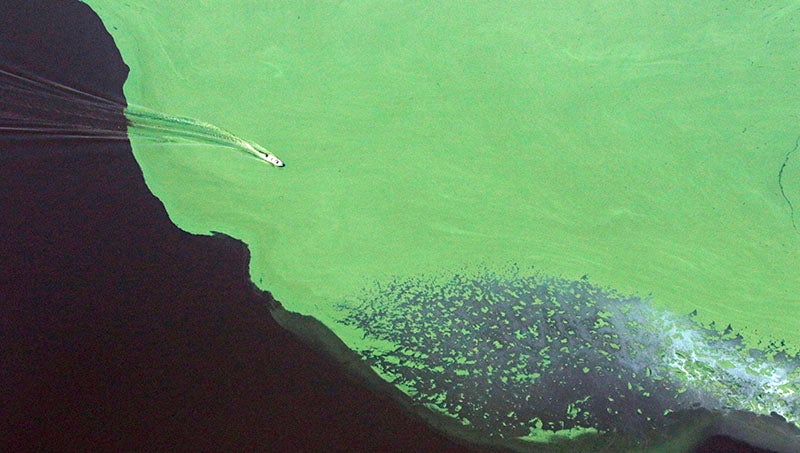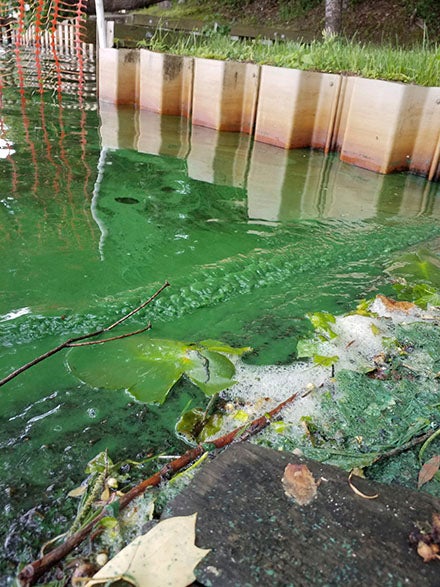DEQ specialist weighs in on blue-green algae and what to watch out for
Published 7:30 pm Tuesday, August 13, 2019

- FLOURESCENCE: For the past several years, those living on the Chowan or Albemarle rivers have had seen many blue-green algal blooms that have the potential to be toxic. In July, one such bloom off a waterfront neighborhood on the Chowan River tested positive for toxins, which can harm both humans and pets. (Jill Paxson)
Eastern North Carolina made waves this week with the death of three pets that died after a swim in toxic water.
According to Associated Press, the dogs were on a jaunt with their owner in Wilmington, when she unknowingly allowed them to swim in a pond contaminated by blue-green algae, or cyanobacteria. Hours later, all three died, despite veterinary treatment.
Blue-green algae flourishes in low-flowing waters and feeds off nitrogen in any form it can get it, according to Jill Paxson, an environmental senior specialist with North Carolina Department of Environmental Quality’s Division of Water Resources. Paxson is one of three specialists whose job it is to track down and test water quality complaints across 21 counties in eastern North Carolina.
To Beaufort County residents concerned about pets or livestock drinking or swimming in local waterways, Paxson said there are signs to look for. Blue-green algae actually can appear in a variety of colors, from florescent green to red, so discolored water with a sheen on the surface could be an indicator of its presence. Murky water or a recent fish kill could also point to cyanobacteria.
“As far as the Pamlico River is concerned, we haven’t found any florescent green water. I was out last week, and it was really clear. The oxygen levels were really good,” Paxson said. “But conditions can change.”
Conditions did change this summer on the Chowan and Albemarle rivers, where blue-green algae blooms have turned the water fluorescent green in certain hotspots. Referred to as PHABs, or potential harmful algal blooms, a thriving blue-green algal bloom may or may not be toxic. PHABs have the ability to produce toxins — neurotoxins that affect the nervous and respiratory systems or hepatotoxins, which affect the liver — but they often do not produce them at all, Paxson said.
“It might not be toxic today, but it might be tomorrow,” Paxson said.
That scenario happened at the Arrowhead Beach neighborhood on the Chowan River in late July, when samples unexpectedly came back positive for toxins.
“We’d been seeing florescent green water, but it wasn’t toxic,” Paxson said. “This was the first time that we’ve found a really hot site.”

BLOOM FROM ABOVE: A toxic algal bloom on the Chowan River can be seen in this aerial photo taken four years ago by a Sound Rivers intern. (Sound Rivers)
It’s the changeability that should keep people, and pet owners, wary of PHABs.
“We really haven’t had too many hits that would impair human health or even dog health but, unlike when dogs are in the water, we know not to swallow water indirectly. They’re going to get it on their fur, they’re going to shake, but they’re also going to lick themselves clean. That is the pathway to ingestion,” Paxson said.
Paxson said it’s important to rinse off, whether human or animal, after a dip in the water, and those with open sores should avoid it altogether.
“You’ve got to trust your instincts and know, if you’ve been living here long enough, if you see something that doesn’t seem right,” Paxson said. “If you see (water) that’s not normal, remember it. If it doesn’t look right, take a picture. Email it to me.”
Jill Paxson can be reached at jill.paxson@ncdenr.gov.





